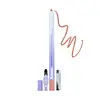What's inside
What's inside
 Key Ingredients
Key Ingredients

 Benefits
Benefits

 Concerns
Concerns

 Ingredients Side-by-side
Ingredients Side-by-side

Tridecyl Trimellitate
EmollientOctyldodecanol
EmollientDicalcium Phosphate
AbrasiveSynthetic Wax
AbrasiveCaprylic/Capric Triglyceride
MaskingDiisostearyl Malate
EmollientSynthetic Beeswax
Emulsion StabilisingHelianthus Annuus Seed Wax
Skin ConditioningRosa Canina Fruit Oil
EmollientSalicornia Herbacea Extract
Skin ConditioningUndaria Pinnatifida Extract
Skin ConditioningSodium Hyaluronate
HumectantRubus Idaeus Leaf Extract
Skin ConditioningRicinus Communis Seed Oil
MaskingDisteardimonium Hectorite
StabilisingPropylene Carbonate
SolventPentaerythrityl Tetra-Di-T-Butyl Hydroxyhydrocinnamate
AntioxidantHydrogenated Castor Oil
EmollientCI 77120
Cosmetic ColorantTitanium Dioxide
Cosmetic ColorantCI 15850
Cosmetic ColorantMica
Cosmetic ColorantCI 19140
Cosmetic ColorantCI 77491
Cosmetic ColorantCI 77492
Cosmetic ColorantCI 77499
Cosmetic ColorantCI 45410
Cosmetic ColorantCI 42090
Cosmetic ColorantCI 45380
Cosmetic ColorantCI 15985
Cosmetic ColorantTridecyl Trimellitate, Octyldodecanol, Dicalcium Phosphate, Synthetic Wax, Caprylic/Capric Triglyceride, Diisostearyl Malate, Synthetic Beeswax, Helianthus Annuus Seed Wax, Rosa Canina Fruit Oil, Salicornia Herbacea Extract, Undaria Pinnatifida Extract, Sodium Hyaluronate, Rubus Idaeus Leaf Extract, Ricinus Communis Seed Oil, Disteardimonium Hectorite, Propylene Carbonate, Pentaerythrityl Tetra-Di-T-Butyl Hydroxyhydrocinnamate, Hydrogenated Castor Oil, CI 77120, Titanium Dioxide, CI 15850, Mica, CI 19140, CI 77491, CI 77492, CI 77499, CI 45410, CI 42090, CI 45380, CI 15985
Trimethylsiloxysilicate
EmollientIsohexadecane
EmollientSynthetic Wax
AbrasiveEthylhexyl Palmitate
EmollientKaolin
AbrasiveCeresin
Emulsion StabilisingMica
Cosmetic ColorantIsododecane
EmollientPolybutene
Vp/Hexadecene Copolymer
Copernicia Cerifera Wax
Sodium Hyaluronate
HumectantEthylene/Propylene Copolymer
AbrasiveCaprylyl Glycol
EmollientGlyceryl Caprylate
EmollientGlucomannan
Skin ConditioningTrihydroxystearin
Skin ConditioningCI 77891
Cosmetic ColorantCI 77491
Cosmetic ColorantCI 77492
Cosmetic ColorantCI 77499
Cosmetic ColorantCI 15850
Cosmetic ColorantTrimethylsiloxysilicate, Isohexadecane, Synthetic Wax, Ethylhexyl Palmitate, Kaolin, Ceresin, Mica, Isododecane, Polybutene, Vp/Hexadecene Copolymer, Copernicia Cerifera Wax, Sodium Hyaluronate, Ethylene/Propylene Copolymer, Caprylyl Glycol, Glyceryl Caprylate, Glucomannan, Trihydroxystearin, CI 77891, CI 77491, CI 77492, CI 77499, CI 15850
 Reviews
Reviews

Ingredients Explained
These ingredients are found in both products.
Ingredients higher up in an ingredient list are typically present in a larger amount.
Ci 15850 is the pigment color red. It is an azo dye and created synthetically.
Azo dyes need to be thoroughly purified before use. This allows them to be more stable and longer-lasting.
This ingredient is common in foundations, lipsticks, and blushes. This color is described as brown/orangey red.
It has many secondary names such as Red 6 and Red 7. According to a manufacturer, Red 6 usually contains aluminum.
Learn more about CI 15850Ci 77491 is also hydrated iron III oxide. It's sole purpose is to give a red/pink hue to products.
Iron III oxides are classified as inorganic chemicals for coloring.
Synthetically created Ci 77491 is considered safer than those naturally found. This is because the synthetically created version may contain less impurities. Iron oxides are generally non-toxic and non-allergenic.
Learn more about CI 77491Ci 77492 is also hydrated iron III oxide. It's sole purpose is to give a yellow hue to products.
Iron III oxides are classified as inorganic chemicals for coloring.
Synthetically created Ci 77492 is considered safer than those naturally found. This is because the synthetically created version may contain less impurities. Iron oxides are generally non-toxic and non-allergenic.
Learn more about CI 77492Ci 77499 is also hydrated iron III oxide. It is created from mixing red and black iron oxides. This helps give shades of darkness to a product.
Iron III oxides are classified as inorganic chemicals for coloring.
Mica is a naturally occurring mineral used to add shimmer and color in cosmetics. It can also help improve the texture of a product or give it an opaque, white/silver color.
Serecite is the name for very fine but ragged grains of mica.
This ingredient is often coated with metal oxides like titanium dioxide. Trace amounts of heavy metals may be found in mica, but these metals are not harmful in our personal products.
Mica has been used since prehistoric times throughout the world. Ancient Egyptian, Indian, Greek, Roman, Aztec, and Chinese civilizations have used mica.
Learn more about MicaSodium Hyaluronate is hyaluronic acid's salt form. It is commonly derived from the sodium salt of hyaluronic acid.
Like hyaluronic acid, it is great at holding water and acts as a humectant. This makes it a great skin hydrating ingredient.
Sodium Hyaluronate is naturally occurring in our bodies and is mostly found in eye fluid and joints.
These are some other common types of Hyaluronic Acid:
Learn more about Sodium HyaluronateSynthetic Wax is created from fossil fuels such as natural gas. It is used to enhance texture, adjust pH, and as an occlusive.
It may also be used as an abrasive ingredient to exfoliate the skin.
Synthetic Wax may not be fungal acne safe.
Learn more about Synthetic Wax